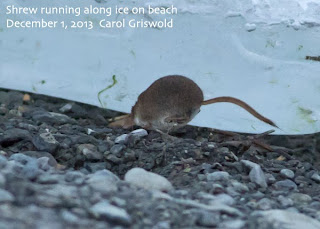Seward, Alaska
Sunrise 9:34 am,
sunset 3:58 pm for a total daylight of 6 hours and 23 minutes. Tomorrow will be
3 minutes and 11 seconds shorter.
Sunny, clear
skies, temps from 18 to 21º with a strong NNE wind from 19-25 mph with gusts
maxing out at 43 mph.
Fourth of July
Beach
At first, I
thought it was just another wind-blown brown alder leaf skittering along the
frozen beach. Then I realized the wind blew from a different direction and this
little one must be self-propelled. I hurried over to see a tiny brown animal
dash underneath a collapsed ice sheet. A vole? Here at the edge of the tide,
far from any vegetation or shelter?
I waited
patiently and after several long minutes, the little brown ball with a light
belly reappeared and bounced along on its short pink legs, a long tail trailing
behind. I got a better glimpse of the long pointy nose and minute ears and
realized it was a shrew! Such a busy little creature, poking and probing
through the tide wrack and beach debris for calories.
I moved about
20-30' back so my observant young dog would not bother it. Keeping her occupied
with a well-placed stick to fetch, I kept watching the busy shrew. Suddenly, it
made a beeline for me! I watched in astonishment as the tiny mammal bounced
along, tail streaming behind. I stopped it with my boot, then lifted up the
toe. It shot underneath and sat there, calmly looking around, as if it came to
say hello and have a cup of tea. I just couldn't believe it! How did it perceive me, standing
directly into the sun and downwind? Why would it risk such a long dash in the
open to an unknown destination?
I stealthily got
out my point and shoot camera and tried to get a few photos without
accidentally crushing it. It was truly round like a ball with tiny black eyes.
Long whiskers arced from each side of its pointy pink nose. Its pink bare legs
and feet must get terribly cold in this wintry weather.
Knowing I could
not keep this secret from my dog for very long, I carefully took a giant step away, and
threw the dog's stick far from the now exposed marvel. Immediately, the little
shrew obligingly bounced back to the relative safety of the ice shelf and
resumed foraging. What an incredible, unexpected connection between a totally wild animal and
a human!
Upon returning
home, I did a little research. Of the 10 known shrew species in Alaska, this is
likely either the Common/Masked Shrew or the Dusky Shrew. It is really hard to
determine the species without doing skull and teeth analyses, but those two
species seem to be in our range and habitat. They do not hibernate, and must
spend most of its short life foraging for food. The Dusky Shrew lives 16-18
months, weighs 4.4 to 10.2 grams (a penny weighs 3 grams), and is 95-139 mm
long.
Shrews resemble
mice, but are not rodents. They are insectivores with sharp teeth that eventually wear
down. They eat insects, spiders, invertebrates, and some also eat fish, seeds,
and plants. They must eat almost constantly, day and night, year round, due to
their high metabolism, up to 3x its weight in food a day. What an amazing animal!
<
http://www.mnh.si.edu/mna/image_info.cfm?species_id=326>
<
http://en.wikipedia.org/wiki/Cinereus_Shrew>
< www.adfg.alaska.gov/static/education/wns/shrews.pdf>
One never knows
what to expect on the Nature Show! The program airs 24/7, no subscription
necessary, and is full of mystery, surprise, beauty, and inspiration. See you
outside!
Happy Birding!
Carol Griswold
Seward Sporadic
Bird Report Reporter




No comments:
Post a Comment